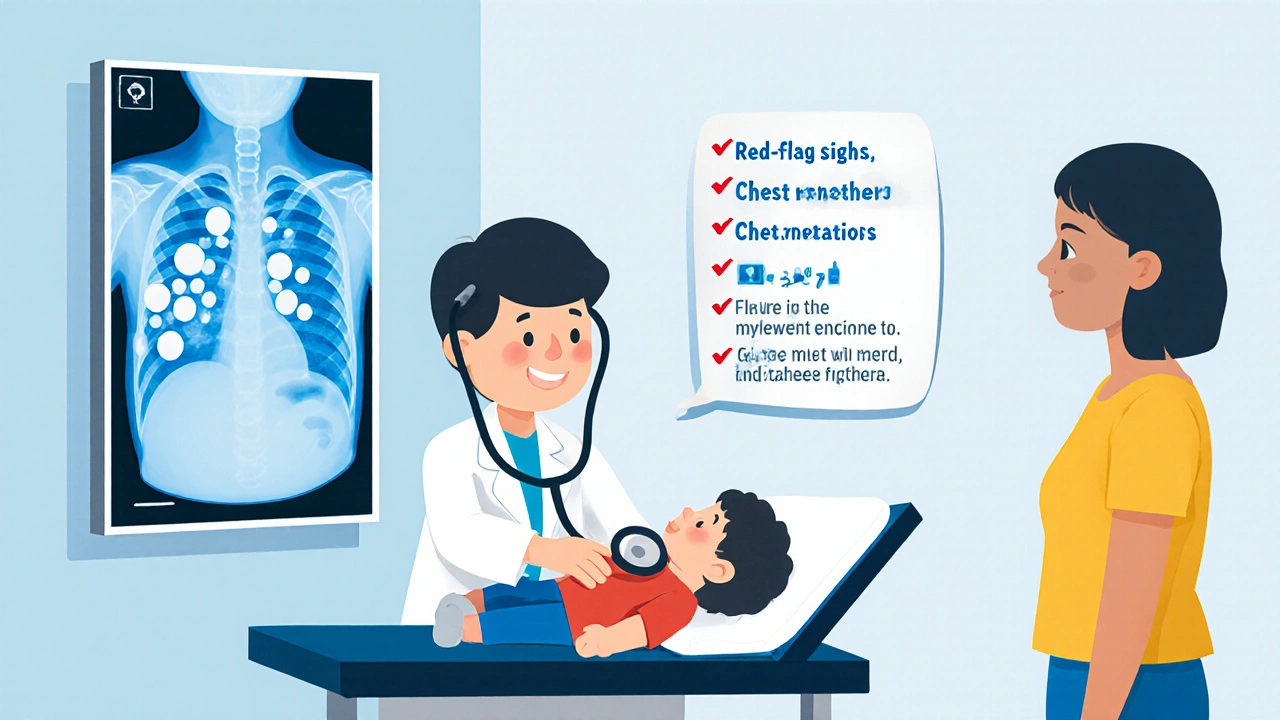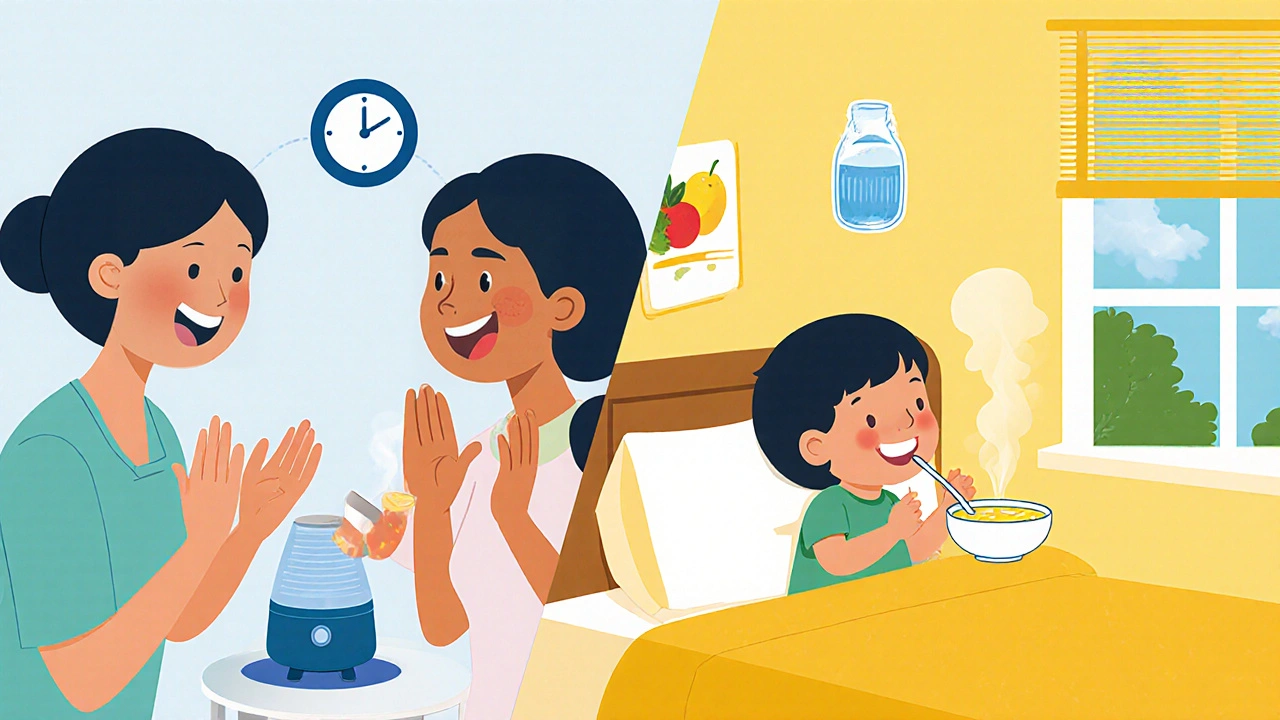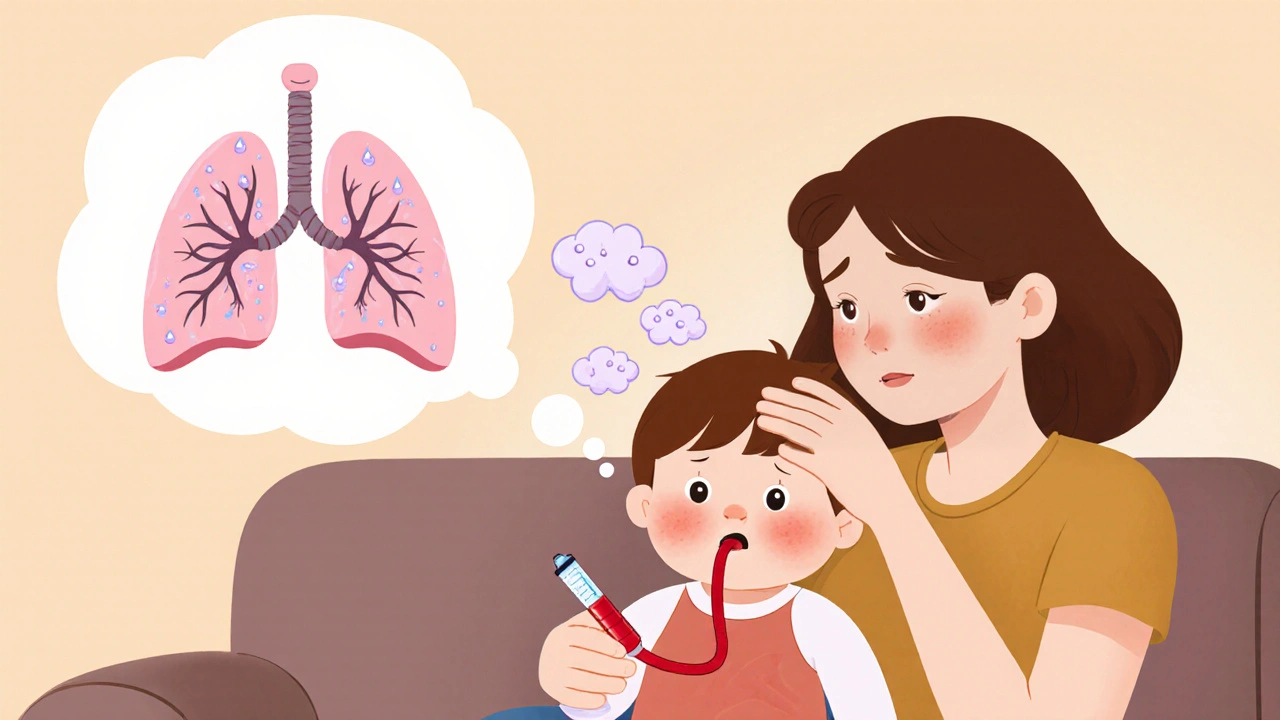Childhood Pneumonia Symptom Checker
Assess Your Child's Symptoms
This tool helps you determine if your child's symptoms require immediate medical attention based on WHO and CDC guidelines.
Assessment Results
Summary:
Next Steps
When your child starts coughing, fever spikes, or seems unusually tired, panic can set in. Understanding pneumonia in children is a lung infection that inflames the air sacs, often filling them with fluid or pus can turn that fear into actionable steps. This guide walks you through the basics, the red‑flag signs that need urgent care, and the everyday measures that keep your little one safe.
What Exactly Is Pneumonia in Kids?
Pneumonia is an infection of the lungs. In children, the disease can be caused by bacteria, viruses, or, less commonly, fungi. According to the World Health Organization, pneumonia accounts for roughly 15% of all deaths in children under five worldwide, but in high‑income countries like the United States the mortality rate is low thanks to vaccines and early treatment.
Key facts:
- Most cases in children under 5 are viral.
- Bacterial pneumonia peaks in toddlers (12‑36 months) when the immune system is still maturing.
- Seasonal spikes often align with the flu and RSV (Respiratory syncytial virus) seasons.
Common Signs and Symptoms to Watch For
Children don’t always verbalize what’s wrong, so look for these clues:
- Rapid or shallow breathing, sometimes accompanied by chest retractions (skin pulling inward).
- Fever above 38°C (100.4°F) that persists beyond 24‑48 hours.
- A persistent cough that may be wet (phlegmy) or dry.
- General lethargy or irritability, especially in infants.
- Reduced appetite or difficulty feeding.
These symptoms overlap with other respiratory illnesses, but the combination of fever, breathing difficulty, and a cough lasting more than a couple of days should raise concern.
How Doctors Diagnose the Condition
Diagnosis starts with a thorough history and physical exam. The clinician will listen for crackles or wheezing using a stethoscope. If pneumonia is suspected, they’ll likely order:
- Chest X-ray - provides a visual of fluid‑filled air sacs and helps differentiate bacterial from viral patterns.
- Blood tests (CBC) to check white‑blood‑cell count.
- Pulse oximetry to measure oxygen saturation; levels below 92% in children usually warrant supplemental oxygen.
In some cases, especially for severe infections, a sputum culture or PCR swab may be taken to identify the exact pathogen.

Treatment Options: What to Expect
The treatment plan hinges on whether the pneumonia is bacterial or viral.
| Attribute | Bacterial Pneumonia | Viral Pneumonia |
|---|---|---|
| Typical Cause | Streptococcus pneumoniae, Haemophilus influenzae | Respiratory syncytial virus (RSV), Influenza, Parainfluenza |
| Fever Pattern | High, often >39°C, lasts >3 days | May be moderate, can fluctuate |
| Chest X‑ray | Lobar consolidation | Diffuse interstitial infiltrates |
| Treatment | Course of Antibiotics (e.g., amoxicillin) | Supportive care - fluids, fever reducers, possible antiviral (oseltamivir for flu) |
| Hospitalization | More likely if severe or infant | Rare, unless respiratory distress |
For bacterial cases, a 5‑day antibiotic course is typical. Doctors may choose amoxicillin, especially if the child is under 5 and has no recent antibiotic exposure. In areas with high resistance, a broader‑spectrum agent may be needed.
Supportive care is universal: maintain hydration, use acetaminophen for fever, and keep the child’s head elevated to ease breathing.
Red‑Flag Signs: When to Call a Doctor Immediately
While many cases can be managed at home, these warning signs require urgent medical attention:
- Breathing faster than 60 breaths per minute (infants) or 40 breaths per minute (toddlers).
- Persistent chest retractions or grunting sounds.
- Blue tinge around lips or fingertips (sign of low oxygen).
- Vomiting repeatedly, leading to dehydration.
- Fever that does not respond to medication after 24 hours.
If any of these appear, head straight to the nearest emergency department or call emergency services.
Prevention: Reducing the Risk of Pneumonia
Vaccination is the single most effective tool. The routine childhood immunization schedule includes:
- PCV13 vaccine - protects against 13 strains of Streptococcus pneumoniae.
- Hib vaccine - guards against Haemophilus influenzae type b.
- Influenza vaccine, given annually.
- Optional RSV prophylaxis (palivizumab) for high‑risk infants.
Other practical steps:
- Frequent hand‑washing with soap for at least 20 seconds.
- Avoid close contact with sick individuals during peak seasons.
- Ensure good indoor air quality; use humidifiers in dry climates.
- Maintain a balanced diet rich in fruits, vegetables, and vitamin D.
- Keep up-to-date on all routine immunizations.

Managing Recovery at Home
Even after starting antibiotics, recovery can take a week or more. Help your child heal faster by:
- Offering small, frequent meals-soups, smoothies, and yogurt are easy to swallow.
- Encouraging light activity when breathlessness eases; short walks boost lung function.
- Monitoring temperature twice daily; keep a fever log for the pediatrician.
- Ensuring the child rests in a well‑ventilated room; avoid cigarette smoke.
- Completing the full antibiotic course, even if symptoms improve.
Schedule a follow‑up chest X‑ray or clinical review if fever persists beyond 48 hours after antibiotics start, or if breathing worsens.
Quick Takeaways for Busy Parents
- Know the common signs: fever, cough, rapid breathing.
- Seek urgent care for blue lips, severe breathing trouble, or persistent high fever.
- Vaccines (PCV13, Hib, flu) dramatically cut risk.
- Antibiotics treat bacterial pneumonia; viral cases need supportive care.
- Finish the full medication course and keep the child hydrated.
Armed with this knowledge, you can act quickly, reduce anxiety, and give your child the best chance for a smooth recovery.
Frequently Asked Questions
How long does pneumonia usually last in children?
Mild cases often improve within 5‑7 days after starting treatment, but a full recovery-including return to normal activity-can take 2‑3 weeks.
Can pneumonia be caught from a sibling?
Yes. The germs that cause pneumonia spread via droplets, so close household contact increases risk. Good hand hygiene and keeping sick kids isolated can help.
Do I need to bring my child’s immunization record to the doctor?
Absolutely. The pediatrician uses the record to decide which vaccines are due and to assess susceptibility to certain bacterial strains.
Is it safe to give my child over‑the‑counter cough medicine?
Most pediatricians recommend against cough suppressants for children under 6 years. Keep the airway clear with fluids and a humidifier instead.
When can my child return to school?
Typically after 24 hours of being fever‑free without the use of fever‑reducers and when breathing is normal. Follow your school’s specific health policy.
Remember, early detection and proper care turn a scary diagnosis into a manageable episode. Keep this guide handy, stay on top of vaccinations, and don’t hesitate to call your pediatrician if anything feels off.
For quick reference, here’s the core keyword highlighted once: pneumonia in children.


The thin veil between childhood innocence and the invisible armies of microbes reminds us that health is a fragile contract.
When a fever spikes, the body is signaling a covert battle that parents must decode.
Modern medicine offers antibiotics, yet whispers of hidden agendas linger in the shadows of pharmaceutical corridors.
Trust in vaccination should be balanced with a vigilant eye on the data streams that flow through research institutions.
Parents can empower themselves by reading peer‑reviewed studies and noting the patterns of symptom progression.
Ultimately, a calm mind coupled with informed action forms the best shield against pneumonia in children.
When a child coughs and struggles for breath, the panic that surges through a parent’s veins is both natural and powerful.
That surge can be harnessed into purposeful steps if you understand the underlying mechanisms of pneumonia.
First, recognize that most pediatric cases are viral, which means antibiotics are not the frontline hero.
Viral infections rely on the body’s own immune orchestra to clear the invader, supported by hydration and rest.
Bacterial pneumonia, though less common, demands a short course of antibiotics for a swift resolution.
The hallmark signs-persistent fever, rapid breathing, and a chest that feels hard to expand-should never be ignored.
If any of those red‑flag symptoms appear, a pediatrician’s assessment within the hour becomes essential.
They will likely order a chest X‑ray, because a picture of the lungs can distinguish between lobar consolidation and diffuse infiltrates.
Blood work, though not always necessary, can reveal elevated white cells that suggest a bacterial cause.
Pulse oximetry is a quick, painless way to gauge whether the child’s oxygen levels have dipped below the safe threshold.
While waiting for the doctor, keep the child’s head elevated and offer small, frequent sips of fluid to prevent dehydration.
Avoid exposure to cigarette smoke and indoor pollutants, as they can exacerbate breathing difficulties.
The vaccination schedule-PCV13, Hib, and the annual flu shot-remains the most reliable barrier against severe disease.
Even after antibiotics are prescribed, completing the full course prevents resistance and relapse.
In the end, staying calm, staying informed, and staying proactive will guide you through the storm of childhood pneumonia.
Oh, because the CDC forgot to mention that viruses magically disappear after a week.
Vaccines work the way they’re meant to and they saved millions of kids worldwide they’re not some conspiracy in a lab but a public health triumph we should all support
Indeed, while the guide praises immunizations, one must also consider the silent contracts hidden in vaccine patents 🤔💉. The global health elite often weave narratives that obscure the true cost of data collection, and vigilant parents should demand transparency alongside protection.
Look, I’m not a doctor, but I’ve read a ton of articles,,,, and the consensus seems clear: keep the kid hydrated,,,, maintain a clean environment,,,, and seek professional help if the breathing gets too fast… Also, don’t forget the meds, they’re important!!
Breathing rates over 60 per minute in infants demand immediate ER attention.